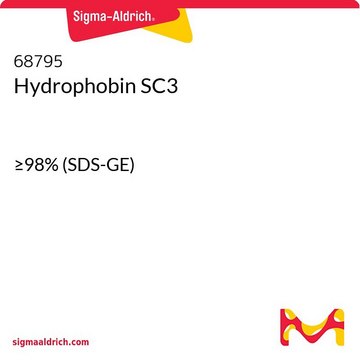PE0220
Plant Hydrophobic Protein Extraction Kit
Suitable for any plant species or tissue
Anmeldenzur Ansicht organisationsspezifischer und vertraglich vereinbarter Preise
Alle Fotos(1)
About This Item
UNSPSC-Code:
41105500
NACRES:
NA.56
Empfohlene Produkte
Lagertemp.
−20°C
Allgemeine Beschreibung
The Plant Hydrophobic Protein Extraction Kit is designed specifically for use in plant bioscience to extract a qualitative sample of hydrophobic proteins from any type of plant species or tissue. The protocol does not require any ultracentrifugation or aqueous polymer two-phase partitioning (APTP). The kit includes three reagents, a plant specific protease inhibitor cocktail, a specially formulated reagent to extract hydrophilic proteins (Plant Protein Extraction Reagent Type 1), and a new chaotropic reagent with increased solubilizing power to extract more hydrophobic proteins (C0356, Protein Extraction Reagent Type 4). The protease inhibitor cocktail is a mixture of protease inhibitors with broad specificity for the inhibition of serine, cysteine, aspartic, metalloproteases, and aminopeptidases. It contains pepstatin A, E-64, leupeptin, 4-(2-aminoethyl)benzenesulfonyl fluoride (AEBSF), bestatin, and 1,10-phenanthroline. The cocktail has been demonstrated to be highly effective in preventing protein degradation during the extraction process.
Following removal of polyphenolics, tannins, and other interfering substances, ground plant tissue, fresh or frozen, is resuspended in a specially formulated reagent to extract hydrophilic proteins. After sequential extractions of the hydrophilic proteins, the chaotropic reagent is used to extract hydrophobic membrane bound proteins. Plant debris is pelleted by centrifugation and the hydrophobic protein extract is collected. The end result is a qualitative hydrophobic protein sample, ready for downstream proteomic analysis.
Following removal of polyphenolics, tannins, and other interfering substances, ground plant tissue, fresh or frozen, is resuspended in a specially formulated reagent to extract hydrophilic proteins. After sequential extractions of the hydrophilic proteins, the chaotropic reagent is used to extract hydrophobic membrane bound proteins. Plant debris is pelleted by centrifugation and the hydrophobic protein extract is collected. The end result is a qualitative hydrophobic protein sample, ready for downstream proteomic analysis.
Menge
Sufficient for preparation of 20 separate extractions from plant tissue samples of 10-250mg
Signalwort
Warning
H-Sätze
Gefahreneinstufungen
Acute Tox. 4 Oral - Aquatic Chronic 2 - Carc. 2 - Repr. 2
Lagerklassenschlüssel
10 - Combustible liquids
Flammpunkt (°F)
185.0 °F
Flammpunkt (°C)
85 °C
Hier finden Sie alle aktuellen Versionen:
Besitzen Sie dieses Produkt bereits?
In der Dokumentenbibliothek finden Sie die Dokumentation zu den Produkten, die Sie kürzlich erworben haben.
Siew-Yong Koay et al.
Journal of chromatography. B, Analytical technologies in the biomedical and life sciences, 879(22), 2179-2183 (2011-06-22)
Orthosiphon aristatus is a traditionally used medicinal plant. In order to study the proteome of the plant, we have developed a simple plant protein extraction method by direct extraction of protein using a modified 2D-gel compatible tris-sucrose buffer followed by
Angus L Dawe et al.
Methods in molecular biology (Clifton, N.J.), 722, 225-236 (2011-05-19)
The interaction of the filamentous fungal plant pathogen Cryphonectria parasitica with its virulence-attenuating viruses provides a unique platform to explore the molecular biology and genetics of virus-host interactions. Following the development of transformation procedures for this fungus, subsequent advances include
M Cilia et al.
Journal of biomolecular techniques : JBT, 20(4), 201-215 (2009-09-02)
Protein extraction methods can vary widely in reproducibility and in representation of the total proteome, yet there are limited data comparing protein isolation methods. The methodical comparison of protein isolation methods is the first critical step for proteomic studies. To
Ramesh Sundar Amalraj et al.
Electrophoresis, 31(12), 1959-1974 (2010-06-22)
Sugarcane is an important commercial crop cultivated for its stalks and sugar is a prized commodity essential in human nutrition. Proteomics of sugarcane is in its infancy, especially when dealing with the stalk tissues, where there is no study to
Yassel Ramos et al.
Analytical biochemistry, 377(2), 134-140 (2008-04-04)
We investigate the selectivity achieved after differential solubilization of bacterial proteomes following two procedures, both based on successive extraction of proteins in solutions of increasing solubilizing power. Recently, these procedures have gained notable popularity and several commercial kits are now
Unser Team von Wissenschaftlern verfügt über Erfahrung in allen Forschungsbereichen einschließlich Life Science, Materialwissenschaften, chemischer Synthese, Chromatographie, Analytik und vielen mehr..
Setzen Sie sich mit dem technischen Dienst in Verbindung.







